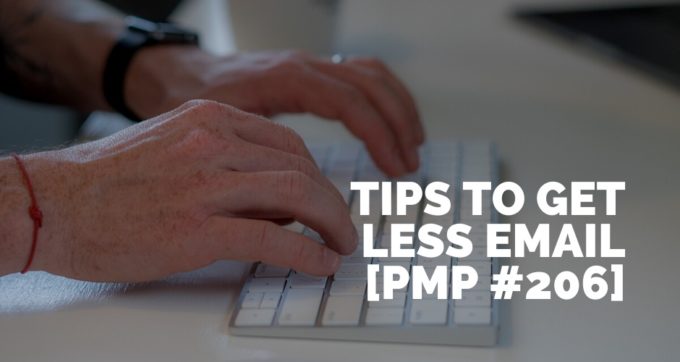Email continues to be one of the main time-sucks for the average knowledge worker. Every morning I’m greeted by about 20-30 new messages. This is a lot less than some people and I still have to schedule time each morning to process my inbox.
In the past, I’ve shared some tips on how to save time on email. In this week’s post, I’d like to drill down into one point in particular, how to get less email. Because if you can reduce the volume of email coming in, this makes processing your inbox a lot quicker.
Don't want to read this post? Listen to the podcast instead:
Want to save time on email? Start by reducing the volume of email you receive!Click To TweetLet’s kick things off with some tips around email mindset:
1. How can I close this loop quicker?
When you’re replying to an email, take some extra time to think about how you can reach a resolution and close the loop quicker. For example, let’s say you’re scheduling a meeting, instead of going back and forth to find a time, could you use a scheduler like Calendly (affiliate link)?
Tim Ferriss shares a useful framework in his book, The 4-Hour Workweek. When typing an email, get into the habit of using an “if… then…” structure. For example, if you’re following up on a quote or proposal, you could say:
“Hi NAME, following up after we spoke the other day to see if you have any feedback on my proposal? If so, please let me know how you’d like to proceed so I can send through next steps. If not, please let me know a suitable time for me to follow up again.”
Using an “if… then…” structure clearly advises the recipient on how to respond to the email to minimise back and forth.
It’s very easy to be lazy when responding to email. We often type the bare minimum to get the message out of our inbox. But if you can put in a little extra effort to get to close the loop quicker, you’ll save time in the long-run.
2. How can I avoid getting emails like this in the future?
Another useful question to be asking yourself is how you can avoid getting similar types of emails in the future.
For example, if you often receive emails from customers or clients who have the same issue with your product or service, how can you fix the problem to reduce the chance of errors in the future.
Before I created a membership area for my products and courses, I used to get a few emails a week from customers who’d be struggling to download their purchase. By hosting all my products inside a membership area I was able to create a better experience for customers and reduce the volume of support emails.
If you receive emails from people asking the same question, is there a resource like a video or an FAQ page that you can make available to answer these questions so people don’t have to email you?
On my websites contact page, I have an FAQ and some policies regarding podcast interview requests and guest posts. Unfortunately, not everyone reads this but it means I don’t have to reply as I’ve clearly stated my position on the website.
Again, this is something that takes a little more effort and won’t necessarily work with every email you receive. But any time you identify a pattern where you get similar emails again and again, this is an opportunity to streamline your process.
3. Unsubscribe!
It goes without saying, if you've subscribed to a lot of newsletters, it’s worth unsubscribing from any that you don’t read or get any value from. I’m very selective about which newsletters I subscribe to.
And sometimes I’ll enjoy a newsletter for a few months but if I start to tune out and notice that I’m no longer reading the newsletters I go ahead and unsubscribe.
Again, laziness is the enemy of email. If you can be more proactive with pruning where email comes from this really helps in the long-run.
4. Use email rules to auto-archive
Sometimes we receive emails that we want to receive but don’t necessarily need to read. A great example of this is payment receipts. Each month I receive email receipts for the online services that I pay for like Zapier or ConvertKit. I want to receive these so I have a record of the payment in my inbox but I don’t really need to see the email.
Using an email rule, you can auto-archive these emails so they skip your inbox and go straight to your archive. That way you don’t have to see it but you’ve still got a record of it in case you need to go back to it in the future.
On that point, if you’re not archiving your email, you really should be.
5. Start fewer new conversations
The more new email threads you start, the more replies you’re going to get. Now, I’m not saying you shouldn’t initiate new conversations. Obviously, if you need to send an email to do your work, that’s fine. This is more something to be aware of than anything. In other words, don’t start a new email conversation unless you have to.
—
What are you doing to reduce incoming email? If you have any tips or feedback, please leave me a comment below!
